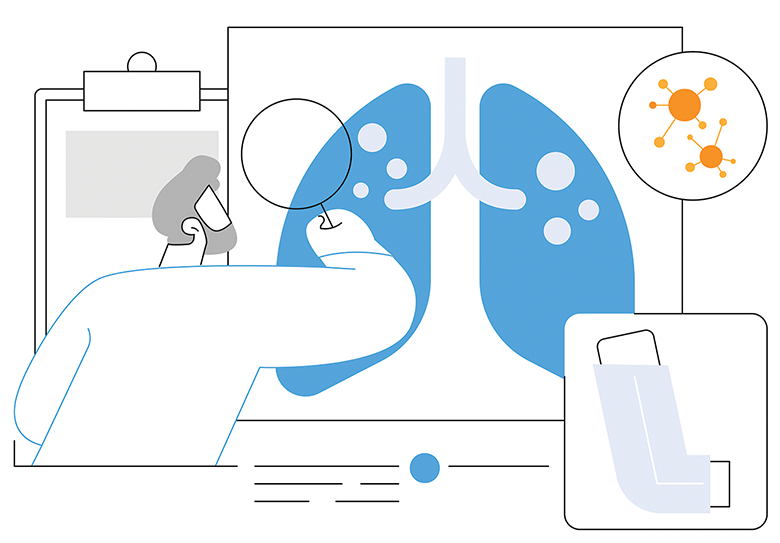COPD CARE began with one University of Wisconsin- Madison pharmacy professor’s vision to help veterans. The primary care service is expanding to VA clinics across the country to reach patients in rural communities.
By Jane E. Rooney
As someone who treats patients in a pulmonary clinic, Dr. Edward Portillo, assistant professor, University of Wisconsin- Madison School of Pharmacy, Pharmacy Practice and Trans- lational Research Division, has seen firsthand the damaging effects of Chronic Obstructive Pulmonary Disease (COPD). He has had patients whose breathing is so labored that they cannot go up a flight of stairs in their own home. For others, the condition interferes with social connections and their ability to work. While the statistics are sobering for the general population—COPD is the sixth-leading cause of death in the United States—the disease takes an even greater toll on the veteran population. Veterans are three times more likely to experience COPD, and it is the second leading cause of hospitalization for VA healthcare users. For his residency project in 2016, Portillo wanted to develop a primary care service to deliver high-quality COPD management to veterans. The result was COPD CARE (Coordinated Access to Reduce Exacerbations), which began at one VA clinic in Madison and has since expanded to more than 30 medical centers and 100 clinics across the country.
“My goal has been to develop a team-based program that positions pharmacists to benefit our veterans,” Portillo explained. “There are treatments and best practices that we know will improve the lives of those with COPD. The difficulty is deliver- ing these best practices routinely to patients. Every healthcare setting is different. Providing optimal care for a high number of patients is difficult. Half of patients with COPD do not receive recommended treatment, and 85 percent of patients with inhalers do not use them as prescribed. There have been examples of programs that integrate COPD best practices at one clinic or medical center, but to scale these programs becomes incredibly difficult. As you scale you often lose the ability to deliver the program with high fidelity, so the effectiveness drops.”
After COPD CARE was selected as a National Gold Status Practice by the Veterans Health Administration in 2018, which provided support to train hundreds of clinicians, the service expanded to more than 20 facilities and 500 practitioners nationwide. In 2021, the program received a Best Practice Award from the American Society of Health-System Pharmacists thanks to impressive results such as reducing hospital/emergency department readmissions from 18 per- cent to 8 percent.
COPD CARE received yet another boost last year with a five-year, $16.7 million grant from the U.S. Department of Veterans Affairs Office of Rural Health, which will fund new positions within the program and support an additional 22 full-time pharmacists in advanced primary care set- tings across the country. “COPD CARE has taken the VA’s team-based model and positioned our pharmacists to use their expertise managing chronic diseases,” Portillo noted. “We’ve leveraged our skillset to support our veterans. We as pharmacists are well positioned to not only serve on these teams but be the ones managing the medications and pre- scribing the right treatments.”
An Action Plan to Empower Veterans
COPD CARE began with Portillo brainstorming ways to optimize team-based care delivery. Patients in the program visit VA clinics and have a primary care provider as well as a clinical pharmacist, termed a Clinical Pharmacist Practitioner (CPP), to prescribe medications, optimize therapy, place critical referrals and prescribe tobacco cessation treatment. Other team members often include nurses and respiratory therapists who are essential to the program’s success. “It’s a collaborative service,” Portillo emphasized. “The pharma- cist is practicing at the top of his or her license. COPD is a progressive disease so if we can administer treatment early, we can slow the progression of this disease and help patients feel better. The pharmacist, nurse, primary care provider and members of the team deliver all of these best practices.”
After patients have been admitted to a hospital or ER following a flare, a nurse from the program calls them 48 hours after discharge to evaluate symptoms, and then the patient is seen at a COPD wellness visit. “We want to empower our veterans to know what to do when they are having symptoms,” he continued. “We developed a COPD action plan. It gives a lot of the power to the patient so they have a plan. We do a follow-up a month later to make sure interventions have been carried out. That leads to an annual visit with a primary care provider. Then there are clear next steps in place so we are optimizing every member of the team.”
In addition to improved access to care and reduced readmission rates, the service identifies more patients for referral services such as pulmonary rehabilitation, tobacco treatment services and telehealth. A significant portion of veterans (92 percent) complete follow-up with a clinician within 30 days after a hospital visit compared to standard of care (49 percent). The service also leads to much greater delivery of COPD best practices, including inhaler technique and adherence review, tobacco use screening and management of COPD comorbidities such as hypertension and diabetes.
CPPs are key to the VA’s team-based model because “they are so incredibly highly trained as healthcare leaders and clinicians,” he said. “We know these medications, we know how to treat patients and we are so good at tailoring treatment regimens to the needs of our patients. Within the VA, CPPs are accustomed to serving on clinical teams and collaborating with team members.”
Portillo initially applied for support through the VA Diffusion of Excellence Office in 2018 with an eye toward broadening the service to communities throughout the United States. His proposal was one of 11 selected from 622 submissions. He worked on creating the COPD CARE Academy, a five-week training program to teach other VA medical centers how to implement COPD CARE and scale it to meet their specific needs. Through his collaboration with the VA Clinical Pharmacy Practice Office, funds were allocated to hire pharmacy student interns, and he noted that those student pharmacists were instrumental in engaging with VA leaders to engineer and build out the Academy.



